2.6 Actions
This section contains detailed reference to all actions available using the Policy Builder interface.
2.6.1 Add Association
Sends an add association command to the Identity Vault, with the specified association.
Fields
- Mode
-
Select whether this actions should be added to the current operation, or written directly to the Identity Vault.
- DN
-
Specify the DN of the target object or leave blank to use the current object.
- Association
-
Specify the value of the association to be added.
Example

2.6.2 Add Destination Attribute Value
Adds a value to an attribute on an object in the destination data store.
Fields
- Attribute Name
-
Specify the name of the attribute.
- Class Name
-
(Optional) Specify the class name of the target object. Leave blank to use the class name from the current object.
- Mode
-
Select whether this action should be added to, before, or after the current operation, or written directly to the destination data store.
- Object
-
Select the target object. This object can be the current object, or be specified by a DN or an association.
- Value Type
-
Select the syntax of the attribute value to be added.
- Value
-
Specify the attribute value to be added.
Example
The example adds the destination attribute value to the OU attribute. It creates the value from the local variables that are created. The rule is from the predefined rules that come with Identity Manager. For more information, see Command Transformation - Create Departmental Container - Part 1 and Part 2.
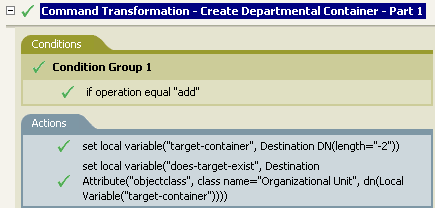
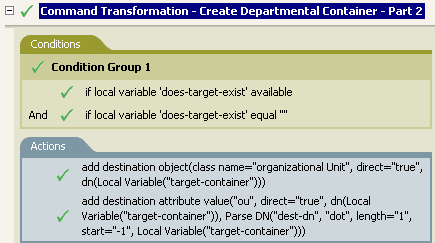
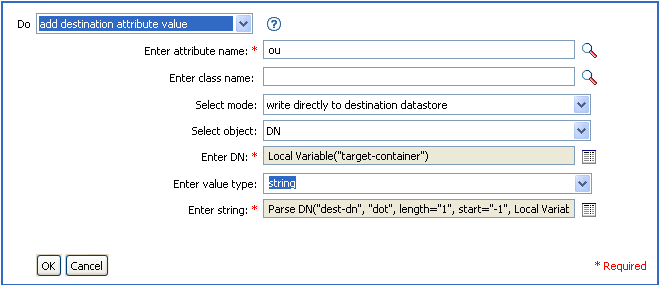
2.6.3 Add Destination Object
Creates a new object in the destination data store.
Fields
- Class Name
-
Specify the class name of the object to be created.
- Mode
-
Select whether this action should be added to, before, or after the current operation, or written directly to the destination data store.
- DN
-
Specify the DN of the object to be created.
Remarks
Any attribute values to be added as part of the object creation must be done in subsequent Section 2.6.2, Add Destination Attribute Value actions using the same DN.
Example
The example creates the department container that is needed. The rule is from the predefined rules that come with Identity Manager. For more information, see Command Transformation - Create Departmental Container - Part 1 and Part 2.



The Organizational Unit object is created. The value for the OU attribute is created from the destination attribute value action that occurs after this action.
2.6.4 Add Source Attribute Value
Adds a value to an attribute on an object in the source data store.
Fields
- Attribute Name
-
Specify the name of the attribute.
- Class Name
-
(Optional) Specify the class name of the target object. Leave blank to use the class name from the current object.
- Object
-
Select the target object. This object can be the current object, or be specified by a DN or an association.
- Value Type
-
Select the syntax of the attribute value to be added.
- Value
-
Specify the attribute value to be added.
Example
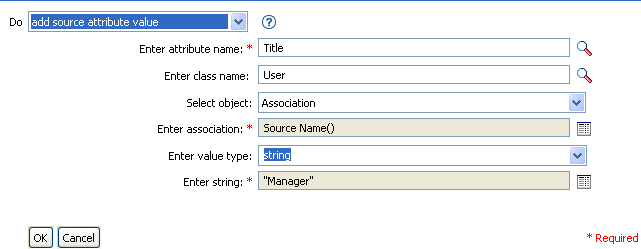
2.6.5 Add Source Object
Creates an object of the specified type to be created in the source data store. Any attribute values to be added as part of the object creation must be done in subsequent Add Source Attribute Value actions using the same DN.
Fields
- Class Name
-
Specify the class name of the object to be added.
- DN
-
Specify the DN of the object to be added.
Example
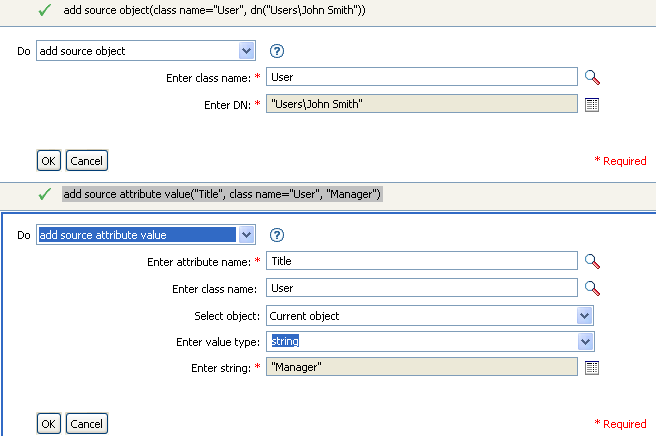
2.6.6 Append XML Element
Appends an element to a set of elements selected by an XPath expression.
Fields
- Variable Name
-
Specify the tag name of the XML element. This name can contain a namespace prefix if the prefix has been previously defined in this policy.
- XPath Expression
-
Specify an XPath 1.0 expression that returns a node set containing the elements to which the new elements should be appended.
Example
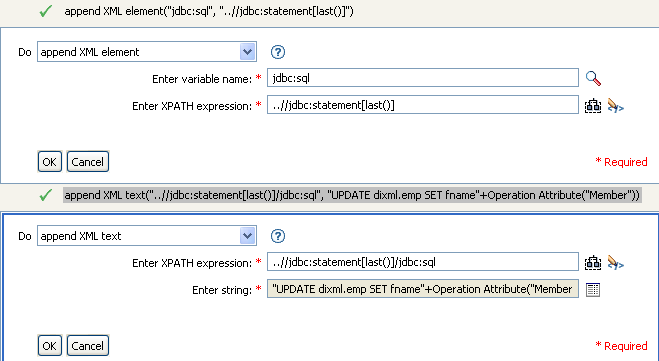
2.6.7 Append XML Text
Appends text to a set of elements selected by an XPath expression.
Fields
- XPath Expression
-
XPath 1.0 expression that returns a node set containing the elements to which the text should be appended.
- String
-
Specify the text to be appended.
Example

2.6.8 Break
Ends processing of the current operation by the current policy.
Example

2.6.9 Clear Destination Attribute Value
Removes the all values of an attribute from an object in the destination data store.
Fields
- Attribute Name
-
Specify the name of the attribute.
- Class Name
-
(Optional) Specify the class name of the target object. Leave blank to use the class name from the current object.
- Mode
-
Select whether this action should be added to, before, or after the current operation, or written directly to the destination data store.
- Object
-
Select the target object. This object can be the current object, or be specified by a DN or an association.
Example

2.6.10 Clear Operation Property
Clears any operation property the current operation.
Fields
- Property Name
-
Specify the name of the operation property to clear.
Example

2.6.11 Clear Source Attribute Value
Removes the all values of an attribute from an object in the source data store.
Fields
- Attribute Name
-
Specify the name of the attribute.
- Class Name
-
(Optional) Specify the class name of the target object. Leave blank to use the class name from the current object.
- Object
-
Select the target object. This object can be the current object, or be specified by a DN or an association.
Example

2.6.12 Clear SSO Credential
Clears the Single Sign On credential, so objects can be deprovisioned. This action is part of the Credential Provisioning policies. For more information, see Section 4.0, Novell Credential Provisioning Policies.
Fields
- Credential Store Object DN
-
Specify the DN of the repository object.
- Target User DN
-
Specify the DN of the target users.
- Application Credential ID
-
Specify the application credential that is stored in the application object.
- Login Parameter Strings
-
Specify each login parameter for the application. The login parameters are the authentication keys stored in the application object.
Example
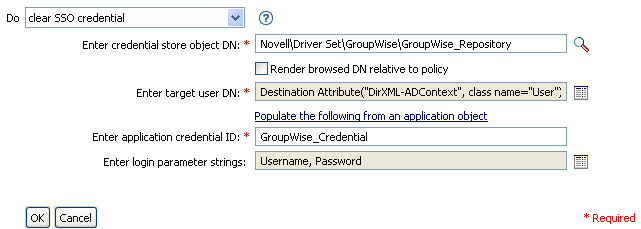
2.6.13 Clone By XPath Expressions
Appends deep copies of a set of XML nodes selected by an XPath expression to a set of elements selected by another XPath expression.
Fields
- Source XPath Expression
-
Specify the XPath 1.0 expression that returns the node set containing the nodes to be copied.
- Destination XPath Expression
-
Specify the XPath 1.0 expression that returns a node set containing the elements to which the copied nodes are to be appended.
Example

2.6.14 Clone Operation Attribute
Copies all occurrences of an attribute within the current operation to a different attribute within the current operation.
Fields
- Source Name
-
Specify the name of the attribute to be copied from.
- Destination Name
-
Specify the name of the attribute to be copied to.
Example
The example adds a User object to the appropriate group, Employee or Manager, based on Title. It also creates the group, if needed, and sets up security equal to that group. The policy is Govern Groups for User Based on Title Attribute, and it is available for download from Novell’s support Web site. For more information, see Downloadable Identity Manager Policies.
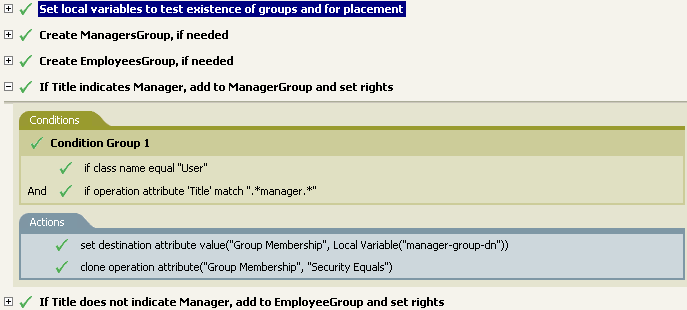

The Clone Operation Attribute is taking the information from the Group Membership attribute and adding that to the Security Equals attribute so the values are the same.
2.6.15 Delete Destination Object
Deletes an object in the destination data store.
Fields
- Mode
-
Select whether this action should be added to, before, or after the current operation, or written directly to the destination data store.
- Object
-
Select the target object. This object can be the current object, or be specified by a DN or an association.
Example

2.6.16 Delete Source Object
Deletes an object in the source data store.
Fields
- Mode
-
Select whether this action should be added to, before, or after the current operation, or written directly to the destination data store.
- Object
-
Select the target object to delete in the source data store. This object can be the current object, or be specified by a DN or an association.
Example

2.6.17 Find Matching Object
Finds a match for the current object in the destination data store.
Fields
- Scope
-
Select the scope of the search. The scope might be an entry, a subordinates, or a subtree.
- DN
-
Specify the DN that is the base of the search.
- Match Attributes
-
Specify the attribute values to search for.
Remarks
Find Matching Object is only valid when the current operation is an add.
The DN argument is required when scope is “entry”, and is optional otherwise. At least one match attribute is required when scope is “subtree” or “subordinates”.The results are undefined if scope is entry and there are match attributes specified. If the destination data store is the connected application, then an association is added to the current operation for each successful match that is returned. No query is performed if the current operation already has a non-empty association, thus allowing multiple find matching object actions to be strung together in the same rule.
If the destination data store is the Identity Vault, then the destination DN attribute for the current operation is set. No query is performed if the current operation already has a non-empty destination DN attribute, thus allowing multiple find matching object actions to be strung together in the same rule. If only a single result is returned and it is not already associated, then the destination DN of the current operation is set to the source DN of the matching object. If only a single result is returned and it is already associated, then the destination DN of the current operation is set to the single character . If multiple results are returned, then the destination DN of the current operation is set to the single character �.
Example
The example matches on Users objects using the attributes CN and L. The location where the rule is searching starts at the Users container and adds the information stored in the OU attribute to the DN. The rule is from the predefined rules that come with Identity Manager. For more information, see Matching - By Attribute Value.


When you click the Argument Builder icon, the Match Attribute Builder comes up. You specify the attribute you want to match in the builder. This examples uses the CN and L attributes.

2.6.18 For Each
Repeats a set of actions for each node in a node set.
Fields
- Node Set
-
Specify the node set.
- Action
-
Specify the actions to perform on each node in the node set.
Remarks
The current node is a different value for each iteration of the actions, if a local variable is used.
If a node in the node set is an entitlement, then the for each implicitly performs an Implement Entitlement action.
Example

The following is an example of the Argument Actions Builder being used to provide the action argument:

2.6.19 Generate Event
Sends a user-defined event to Novell Audit.
Fields
- ID
-
Specify the ID of the event. The ID must be an integer in the range of 1000-1999.
- Level
-
Select the level of the event.
- Strings
-
Specify User-defined string, integer, and binary values to include with the event. These values are provided using the Named String Builder.
Remarks
The Novell Audit event structure contains a target, a subTarget, three strings (text1, text2, text3), two integers (value, value3), and a generic field (data). The text fields are limited to 256 bytes, and the data field can contain up to 3 KB of information, unless a larger data field is enabled in your environment.
Example
The example has four rules that implement a placement policy for User objects based on the first character of the Surname attribute. It generates both a trace message and a custom Novell Audit event. The Generate Event action is used to send an event Novell Audit. The policy name is Policy to Place by Surname, and it is available for download from Novell’s support Web site. For more information Downloadable Identity Manager Policies.
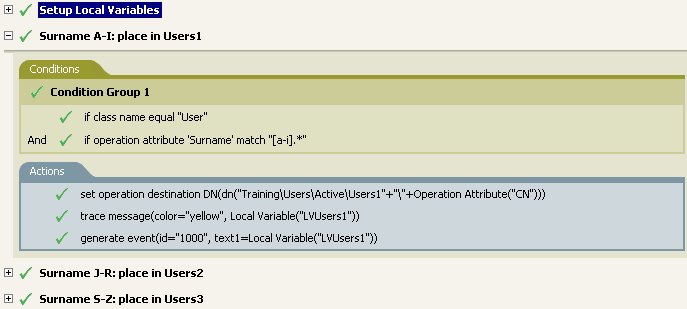

The following is an example of the Named String Builder being used to provide the strings argument.

Generate Event is creating an event with the ID 1000 and displaying the text that is generated by the local variable of LVUser1. The local variable LVUser1 is the string of User:Operation Attribute “cn” +” added to the “+”Training\Users\Active\Users1”+” container”. The event reads User:jsmith added to the Training\Users\Active\Users1 container.
2.6.20 Implement Entitlement
Designates actions that implement an entitlement so that the status of those entitlements might be reported to the agent that granted or revoked the entitlement.
Fields
- Node Set
-
Node set containing the entitlements being implemented by the specified actions.
- Action
-
Actions that implement the specified entitlements.
Example

The following is an example of the Argument Actions Builder, used to provide the action argument:
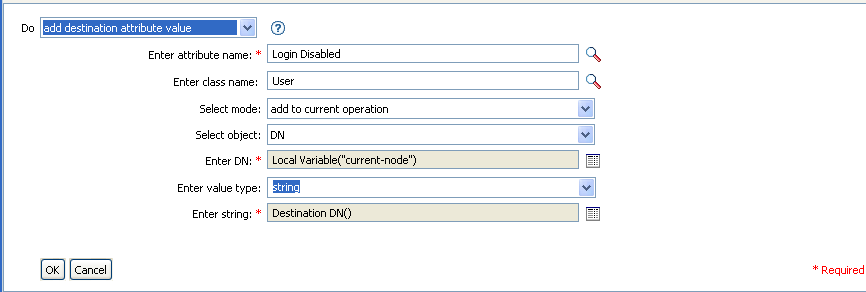
2.6.21 Move Destination Object
Moves an object in the destination data store.
Fields
- Mode
-
Select whether this action should be added to, before, or after the current operation, or written directly to the destination data store.
- Class Name
-
(Optional) Specify the class name of the object to be moved. Leave blank to use the class name from the current object.
- Object to Move
-
Select the object to be moved. This object can be the current object, or can be specified by a DN or an association.
- Container to Move to
-
Select the target container. This container is specified by a DN or an association.
Example
The example contains a single rule that disables a user’s account and moves it to a disabled container when the Description attribute indicates the user is terminated. The policy is named Disable User Account and Move When Terminated, and it is available for download from Novell’s support Web site. For more information, see Downloadable Identity Manager Policies.


The policy checks to see if it is a modify event on a User object and if the attribute Description contains the value of terminated. If that is the case, then it sets the attribute of Login Disabled to true and moves the object to the User\Disabled container.
2.6.22 Move Source Object
Moves an object in the source data store.
Fields
- Object to Move
-
Select the object to be moved. This object can be the current object, or can be specified by a DN or an association.
- Container to Move to
-
Select the target container. This container is specified by a DN or an association.
Example

2.6.23 Reformat Operation Attribute
Reformats all values of an attribute within the current operation using a pattern.
Fields
- Name
-
Specify the name of the attribute.
- Value Type
-
Specify the syntax of the new attribute values.
- Value
-
Specify a value to use as a pattern for the new format of the attribute values. If the original value is needed to constructed the new value, it must be obtained by referencing the local variable current-value.
Example
The example reformats the telephone number. It changes it from (nnn)-nnn-nnnn to nnn-nnn-nnnn. The rule is from the predefined rules that come with Identity Manager. For more information, see Input or Output Transformation - Reformat Telephone Number from (nnn) nnn-nnnn to nnn-nnn-nnnn.


The action reformat operation attribute changes the format of the telephone number. The rule uses the Argument Builder and regular expressions to change how the information is displayed.
2.6.24 Remove Association
Sends a remove association command to the Identity Vault.
Fields
- Mode
-
Select whether this action should be added to, before, or after the current operation, or written directly to the destination data store.
- Association
-
Specify the value of the association to be removed.
Example
The example takes a delete operation and disables the User object instead. It transforms the event. The rule is from the predefined rules that come with Identity Manager. For more information, see Command Transformation - Publisher Delete to Disable.
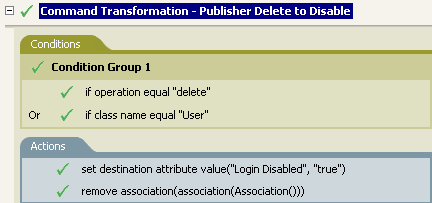

When a delete operation occurs for a User object, the value of the attribute Login Disabled is set to true and the association is removed from the object. The association is removed because the associated object in the connected application no longer exists.
2.6.25 Remove Destination Attribute Value
Removes an attribute value from an object in the destination data store.
Fields
- Attribute Name
-
Specify the name of the attribute.
- Class Name
-
(Optional) Specify the class name of the target object. Leave blank to use the class name from the current object.
- Mode
-
Select whether this action should be added to, before, or after the current operation, or written directly to the destination data store.
- Object
-
Select the target object. This object can be the current object, or can be specified by a DN or an association.
- Value Type
-
Specify the syntax of the attribute value to be removed.
- Value
-
Specify the value of the new attribute.
Example
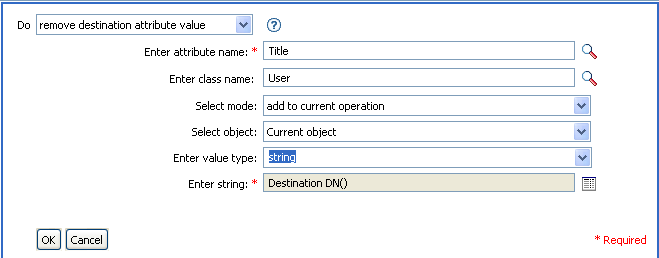
2.6.26 Remove Source Attribute Value
Removes the specified value from the named attribute on an object in the source data store.
Fields
- Attribute Name
-
Specify the name of the attribute.
- Class Name
-
(Optional) Specify the class name of the target object. Leave blank to use the class name from the current object.
- Object
-
Select the target object. This object can be the current object, or can be specified by a DN or an association.
- Value Type
-
Specify the syntax of the attribute value to be removed
- Value
-
Specify the attribute value to be removed.
Example
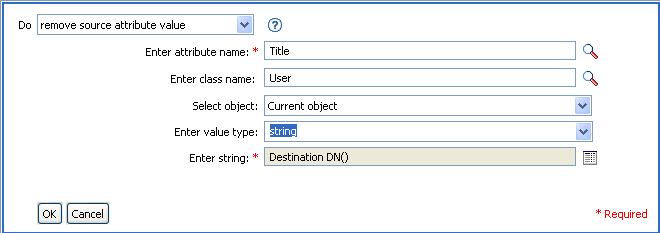
2.6.27 Rename Destination Object
Renames an object in the destination data store
Fields
- Mode
-
Select whether this action should be added to, before, or after the current operation, or written directly to the destination data store.
- Object
-
Select the target object. This object can be the current object, or can be specified by a DN or an association.
- String
-
Specify the new name of the object.
Example
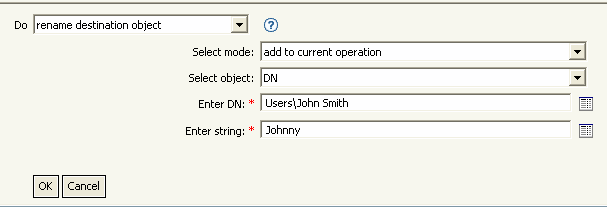
2.6.28 Rename Operation Attribute
Renames all occurrences of an attribute within the current operation.
Fields
- Source Name
-
Specify the original attribute name.
- Destination Name
-
Specify the new attribute name.
Example

2.6.29 Rename Source Object
Renames an object in the source data store.
Fields
- Object
-
Select the target object. This object can be the current object, or specified by a DN or an association.
- String
-
Specify the new name of the object.
Example

2.6.30 Send Email
Sends an e-mail notification.
Fields
- ID
-
(Optional) Specify the User ID in the SMTP system sending the message.
- Server
-
Specify the SMTP server name.
- Password
-
(Optional) Specify the SMTP server account password.
IMPORTANT:The value of the password attribute is stored in clear text.
- Type
-
Select the e-mail message type.
- Strings
-
Specify the values containing the various e-mail addresses, subject, and message. The following table lists valid named string arguments:
Example
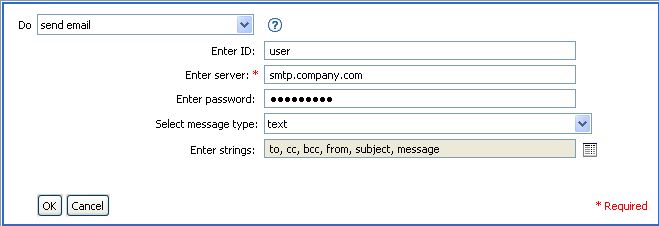
The following is an example of the Named String Builder being used to provide the strings arguments:

2.6.31 Send Email From Template
Generates an e-mail notification using a template.
Fields
- Notification DN
-
Specify the slash form DN of the SMTP notification configuration object.
- Template DN
-
Specify the slash form DN of the e-mail template object.
- Password
-
(Optional) Specify the SMTP server account password.
IMPORTANT:The value of the password attribute is stored in clear text.
- Strings
-
Specify additional fields for the e-mail message. The following table contains reserved field names, which specify the various e-mail addresses:
Each template might also define fields that can be replaced in the subject and body of the email message.
Example

The following is an example of the Named String Builder being used to provide the strings argument:

2.6.32 Set Default Attribute Value
Adds default values to the current operation (and optionally to the current object in the source data store) if no values for that attribute already exist. It is only valid when the current operation is add.
Fields
- Attribute Name
-
Specify the name of the default attribute.
- Write Back
-
Select whether or not to also write back the default values to source data store.
- Values
-
Specify the default values of the attribute.
Example
The example sets the default value for the attribute company. You can set the value for an attribute of your choice. The rule is from the predefined rules that come with Identity Manager. For more information, see Creation - Set Default Attribute Value.



To build the value, the Argument Value List Builder is launched. See Argument Value List Builder for more information on the builder. You can set the value to what is needed. In this case, the Argument Builder is used and the text is set to be the name of the company.
2.6.33 Set Destination Attribute Value
Adds a value to an attribute on an object in the destination data store, and removes all other values for that attribute.
Fields
- Attribute Name
-
Specify the name of the attribute.
- Class Name
-
(Optional) Specify the class name of the target object in the destination data store. Leave blank to use the class name from the current object.
- Mode
-
Select whether this action should be added to, before, or after the current operation, or written directly to the destination data store.
- Object
-
Select the target object. This object can be the current object, or be specified by a DN or an association.
- Value Type
-
Select the syntax of the attribute value to set.
- Value
-
Specify the attribute values to set.
Example
The example takes a delete operation and disables the User object instead. The rule is from the predefined rules that come with Identity Manager. For more information, see Command Transformation - Publisher Delete to Disable.

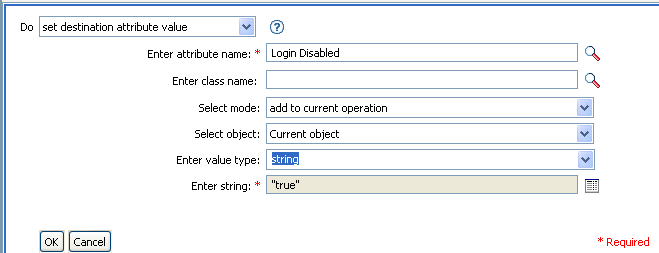
The rule sets the value for the attribute of Login Disabled to true. The rule uses the Argument Builder to add the text of true for the value of the attribute. See Argument Builder for more information about the builder.
2.6.34 Set Destination Password
Sets the password for the current object in the destination data store.
Fields
- Mode
-
Select whether this action should be added to, before, or after the current operation, or written directly to the destination data store.
- Object
-
Select the target object. This object can be the current object, or be specified by a DN or an association.
- String
-
Specify the password to be set.
Example
The example sets a default password for a User object that is created. The rule is from the predefined rules that come with Identity Manager. For more information, see Creation - Set Default Password.
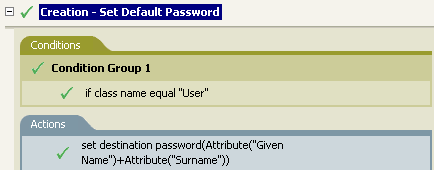

When a User object is created, the password is set to the Given Name attribute plus the Surname attribute.
2.6.35 Set Local Variable
Sets a local variable.
Fields
- Variable Name
-
Specify the name of the local variable.
- Variable Type
-
Select the type of local variable. This can be a string, an XPath 1.0 Node Set, or a Java object.
- Value
-
Specify the value of the local variable.
Example
The example adds a User object to the appropriate group, Employee or Manager, based on Title. It also creates the group, if needed, and sets up security equal to that group. The policy name is Govern Groups for User Based on Title, and it is available for download from Novell’s support Web site. For more information, see Downloadable Identity Manager Policies.
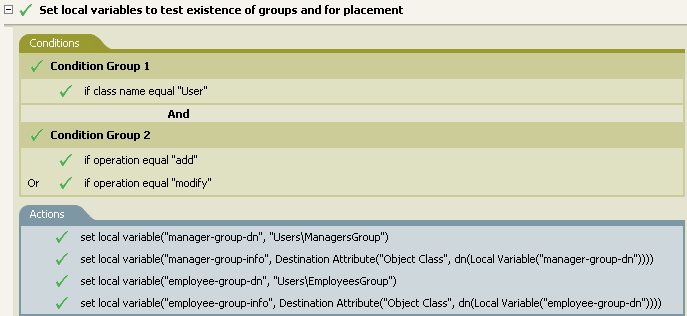

The local variable is set to the value that is in the User object’s destination attribute of Object Class plus the Local Variable of manager-group-info. The Argument Builder is used to construct the local variable. See Argument Builder for more information.
2.6.36 Set Operation Association
Sets the association value for the current operation.
Fields
- Association
-
Provide the new association value.
Example

2.6.37 Set Operation Class Name
Sets the object class name for the current operation.
Fields
- String
-
Provide the new class name.
Example

2.6.38 Set Operation Destination DN
Sets the destination DN for the current operation.
Fields
- DN
-
Specify the new destination DN.
Example
The example places the objects in the Identity Vault using the structure that is mirrored from the connected system. You need to define at what point the mirroring begins in the source and destination data stores. The rule is from the predefined rules that come with Identity Manager. For more information, see Creation - Set Default Attribute Value.
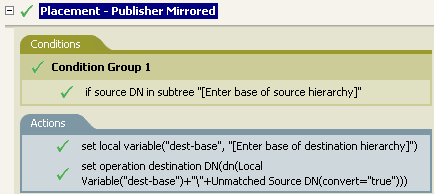

The rule sets the operation destination DN to be the local variable of the destination base location plus the source DN.
2.6.39 Set Operation Property
Sets an operation property. An operation property is a named value that is stored within an operation. It is typically used to supply additional context that might be needed by the policy that handles the results of an operation.
Fields
- Property Name
-
Specify the name of the operation property.
- String
-
Specify the name of the operation property.
Example

2.6.40 Set Operation Source DN
Sets the source DN for the current operation.
Fields
- DN
-
Specify the new source DN.
Example

2.6.41 Set Operation Template DN
Sets the template DN for the current operation to the specified value. This action is only valid when the current operation is add.
Fields
- DN
-
Specify the template DN.
Example
The example applies the Manager template if the Title attribute contains the word Manager. The name of the policy is Policy: Assign Template to User Based on Title, and it is available for download from Novell’s support Web site. For more information, see Downloadable Identity Manager Policies.
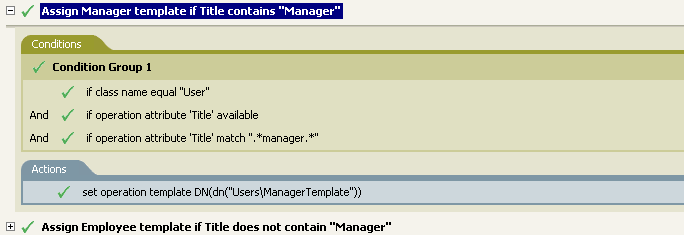

The template Manager Template is applied to any User object that has the attribute of Title available and it contains the word manager somewhere in the title. The policy uses regular expressions to find all possible matches.
2.6.42 Set Source Attribute Value
Adds a value to an attribute on an object in the source data store, and removes all other values for that attribute.
Fields
- Attribute Name
-
Specify the name of the attribute.
- Class Name
-
(Optional) Specify the class name of the target object in the source data store. Leave blank to use the class name from the current object.
- Object
-
Select the target object. This object can be the current object, or be specified by a DN or an association.
- Value Type
-
Select the syntax of the attribute value.
- Value
-
Specify the attribute value to be set.
Example
The example detects when an e-mail address is changed and sets it back to what it was. The policy name is Policy: Reset Value of the E-mail Attribute, and it is available for download from Novell’s support Web site. For more information, see Downloadable Identity Manager Policies.

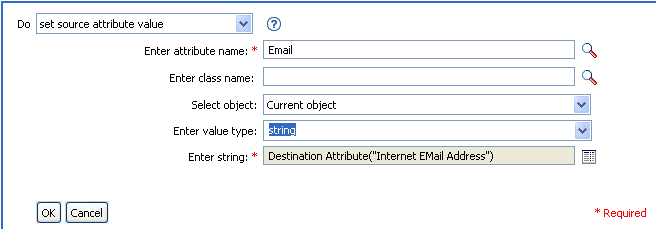
The action takes the value of the destination attribute Internet EMail Address and sets the source attribute of Email to this same value.
2.6.43 Set Source Password
Sets the password for the current object in the source data store.
Fields
- String
-
Specify the password to be set.
Example

2.6.44 Set SSO Credential
Sets the SSO credential when a user object is created or when a password is modified. This action is part of the Credential Provisioning policies. For more information, see Section 4.0, Novell Credential Provisioning Policies.
Fields
- Credential Store Object DN
-
Specify the DN of the repository object.
- Target User DN
-
Specify the DN of the target users.
- Application Credential ID
-
Specify the application credential that is stored in the application object.
- Login Parameter Strings
-
Specify each login parameter for the application. The login parameters are the authentication keys stored in the application object.
Example
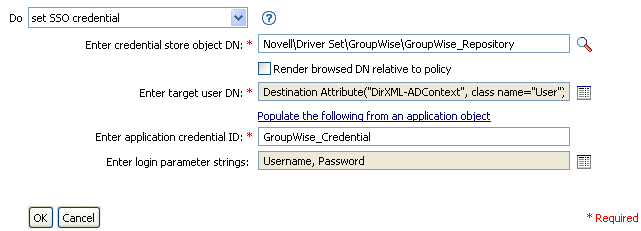
2.6.45 Set SSO Passphrase
Sets the Novell SecureLogin® passphrase and answer when a User object is provisioned. This action is part of the Credential Provisioning policies. For more information, see Section 4.0, Novell Credential Provisioning Policies.
Fields
- Credential Store Object DN
-
Specify the DN of the repository object.
- Target User DN
-
Specify the DN of the target users.
- Question and Answer Strings
-
Specify the SecureLogin passphrase question and answer.
Example

The SecureLogin passphrase question and answer are stored as strings in the policy. Click the
icon
 to launch the string builder. Specify the passphrase question and answer.
to launch the string builder. Specify the passphrase question and answer.
2.6.46 Set XML Attribute
Sets an XML attribute on a set of elements selected by an XPath expression.
Fields
- Name
-
Specify the name of the XML attribute. This name can contain a namespace prefix if the prefix has been previously defined in this policy.
- XPath Expression
-
XPath 1.0 expression that returns a node set containing the elements on which the XML attribute should be set.
- String
-
Specify the value of the XML attribute.
Example
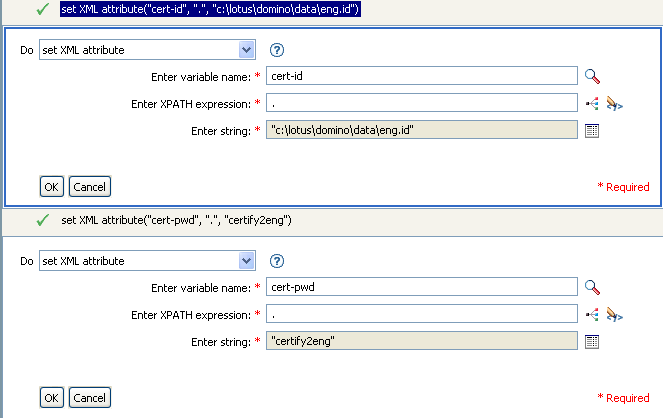
2.6.47 Status
Generates a status notification.
Fields
- Level
-
Specify the status level of the notification.
- Message
-
Provide the status message by using the Argument Builder.
Remarks
If level is retry, then the policy immediately halts processing of the input document and schedules a retry of the event currently being processed.
If level is fatal, then the policy immediately halts processing of the input document and initiates a shutdown of the driver.
If the current operation has an event-id, then that event-id is used for the status notification, otherwise there is no event-id reported.
Example

2.6.48 Strip Operation Attribute
Strips all occurrences of an attribute from the current operation.
Fields
- Name
-
Specify the name of the attribute to be stripped.
Example
The example detects when an e-mail address is changed and sets it back to what it was. The policy name is Policy: Reset Value of the E-mail Attribute, and it is available for download from Novell’s support Web site. For more information, see Downloadable Identity Manager Policies.


The action strips the attribute of Email. The value that is kept is what was in the destination Email attribute.
2.6.49 Strip XPath
Strips nodes selected by an XPath expression.
Fields
- XPath Expression
-
Specify the XPath 1.0 expression that returns the node set containing the nodes to be stripped.
Example

2.6.50 Trace Message
Sends a message to DSTRACE.
Fields
- Level
-
Specify the trace level of the message. The default level is 0. The message only appears if the specified trace level is less than or equal to the trace level configured in the driver.
For information on how to set the trace level on the driver, see
Viewing Identity Manager Processes
in the Novell Identity Manager 3.0.1 Administration Guide . - Color
-
Select the color of the trace message.
- String
-
Specify the value of the trace message.
Example
The example has four rules that implement a Placement policy for User objects based on the first character of the Surname attribute. It generates both a trace message and a custom Novell Audit event. The Trace Message action is used to send a trace message into DSTRACE. The policy name is Policy to Place by Surname, and it is available for download from Novell’s support Web site. For more information Downloadable Identity Manager Policies.


The action sends a trace message to DSTRACE. The contents of the local variable is LVUsers1 and it shows up in yellow in DSTRACE.
2.6.51 Veto
Vetoes the current operation.
Example
The example excludes all events that come from the specified subtree. The rule is from the predefined rules that come with Identity Manager. For more information, see Event Transformation - Scope Filtering - Exclude Subtrees.
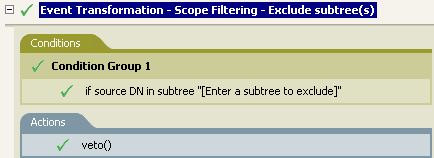

The action vetoes all events that come from the specified subtree.
2.6.52 Veto If Operational Attribute Not Available
Conditionally cancels the current operation and ends processing of the current policy, based on the availability of an attribute in the current operation.
Fields
- Name
-
Specify the name of the attribute.
Example
The example does not allow all User objects to be created unless the attributes Given Name, Surname, Title, Description, and Internet EMail Address are available. The policy name is Policy to Enforce the Presences of Attributes and it is available for download from Novell’s support Web site. For more information, see Downloadable Identity Manager Policies.
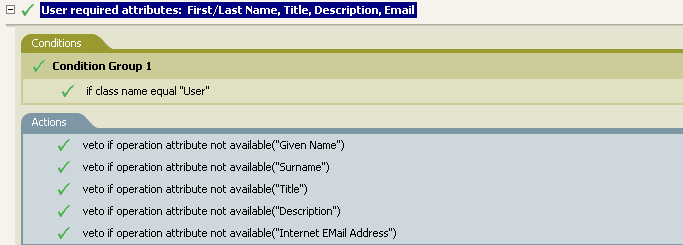

The actions vetoes the operation if the attributes of Given Name, Surname, Title, Description, and Internet Email Address are not available.